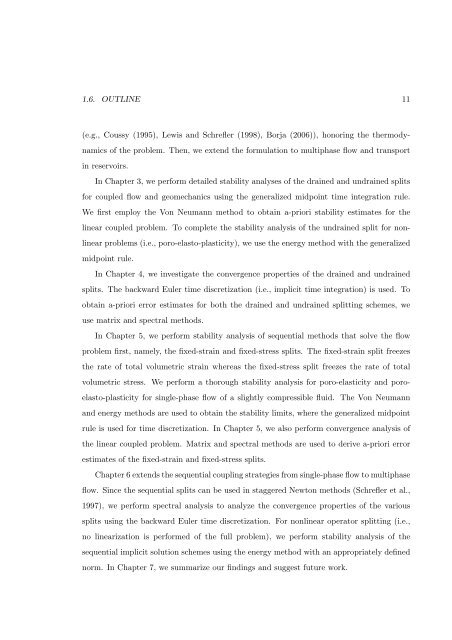Sequential Methods for Coupled Geomechanics and Multiphase Flow
Sequential Methods for Coupled Geomechanics and Multiphase Flow
Sequential Methods for Coupled Geomechanics and Multiphase Flow
You also want an ePaper? Increase the reach of your titles
YUMPU automatically turns print PDFs into web optimized ePapers that Google loves.
1.6. OUTLINE 11<br />
(e.g., Coussy (1995), Lewis <strong>and</strong> Schrefler (1998), Borja (2006)), honoring the thermody-<br />
namics of the problem. Then, we extend the <strong>for</strong>mulation to multiphase flow <strong>and</strong> transport<br />
in reservoirs.<br />
In Chapter 3, we per<strong>for</strong>m detailed stability analyses of the drained <strong>and</strong> undrained splits<br />
<strong>for</strong> coupled flow <strong>and</strong> geomechanics using the generalized midpoint time integration rule.<br />
We first employ the Von Neumann method to obtain a-priori stability estimates <strong>for</strong> the<br />
linear coupled problem. To complete the stability analysis of the undrained split <strong>for</strong> non-<br />
linear problems (i.e., poro-elasto-plasticity), we use the energy method with the generalized<br />
midpoint rule.<br />
In Chapter 4, we investigate the convergence properties of the drained <strong>and</strong> undrained<br />
splits. The backward Euler time discretization (i.e., implicit time integration) is used. To<br />
obtain a-priori error estimates <strong>for</strong> both the drained <strong>and</strong> undrained splitting schemes, we<br />
use matrix <strong>and</strong> spectral methods.<br />
In Chapter 5, we per<strong>for</strong>m stability analysis of sequential methods that solve the flow<br />
problem first, namely, the fixed-strain <strong>and</strong> fixed-stress splits. The fixed-strain split freezes<br />
the rate of total volumetric strain whereas the fixed-stress split freezes the rate of total<br />
volumetric stress. We per<strong>for</strong>m a thorough stability analysis <strong>for</strong> poro-elasticity <strong>and</strong> poro-<br />
elasto-plasticity <strong>for</strong> single-phase flow of a slightly compressible fluid. The Von Neumann<br />
<strong>and</strong> energy methods are used to obtain the stability limits, where the generalized midpoint<br />
rule is used <strong>for</strong> time discretization. In Chapter 5, we also per<strong>for</strong>m convergence analysis of<br />
the linear coupled problem. Matrix <strong>and</strong> spectral methods are used to derive a-priori error<br />
estimates of the fixed-strain <strong>and</strong> fixed-stress splits.<br />
Chapter 6 extends the sequential coupling strategies from single-phase flow to multiphase<br />
flow. Since the sequential splits can be used in staggered Newton methods (Schrefler et al.,<br />
1997), we per<strong>for</strong>m spectral analysis to analyze the convergence properties of the various<br />
splits using the backward Euler time discretization. For nonlinear operator splitting (i.e.,<br />
no linearization is per<strong>for</strong>med of the full problem), we per<strong>for</strong>m stability analysis of the<br />
sequential implicit solution schemes using the energy method with an appropriately defined<br />
norm. In Chapter 7, we summarize our findings <strong>and</strong> suggest future work.
















